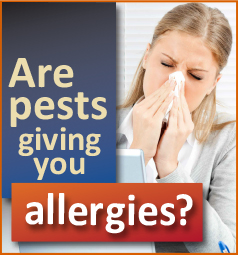Are Insects Giving You Allergies?
There’s no denying that bugs are annoying. They buzz, they bite, they sting, they spoil our backyard BBQs and our game-day tailgates. They reproduce with lightning speed, are almost impossible to avoid and, worst of all, the bites of these pesky buggers can trigger painful allergic reactions.
Which Bugs Cause Reactions?
 Our bodies are uniquely designed to respond to even the smallest invaders, and bees, hornets, wasps, yellow jackets and fire ants have small amounts of venom in their stingers that can send our immune systems into overdrive. Though not as noticeable at the moment of contact, mosquitos inject us with a cocktail of compounds that cause allergies when they exchange their saliva with our blood.
Our bodies are uniquely designed to respond to even the smallest invaders, and bees, hornets, wasps, yellow jackets and fire ants have small amounts of venom in their stingers that can send our immune systems into overdrive. Though not as noticeable at the moment of contact, mosquitos inject us with a cocktail of compounds that cause allergies when they exchange their saliva with our blood.
The diabolical bed bug can also trigger allergic reactions and asthma, and the mere presence of cockroaches and dust mites (and their waste) can trigger asthma and other serious allergic reactions as well.
Mild Allergic Reactions
Given the diversity of our immune systems, there is a wide range of human reactions to insect bites. For most people, bites are relatively harmless. Normal reactions include mild to moderate swelling at the site of the bite, itching, warmth, pain and raised reddish spots that typically subside within a few days to a week.
A more severe response could be characterized as a large, local reaction, which causes swelling beyond the site of the sting or bite. Though they may look nasty, these large responses are no more harmful than mild reactions, and symptoms tend to peak at 48 hours and disappear completely within five to 10 days.
Mild allergic reactions to cockroaches or dust mites may feel more like a cold. As an infestation grows, coughing, sneezing, runny nose, itchy eyes and a sore throat could last for months, and more sensitive people may even suffer from a related asthma attack.
Severe Allergic Reactions
While most bites aren’t harmful, children and adults with immune system disorders can experience severe reactions ranging from intense swelling and redness to hives, a low-grade fever, swollen lymph nodes, headache, blistering and even asthma.
Severe allergic reactions to insect bites affect nearly two million Americans. Also known as anaphylactic reactions, these rare events can trigger a life-threatening emergency. Symptoms of a severe reaction include difficulty breathing, itchy red hives that spread rapidly, swelling of the lips, tongue or throat, wheezing or trouble swallowing, stomach pain, vomiting, bloating, diarrhea, anxiety, rapid pulse, dizziness, fainting, a sharp drop in blood pressure and panic. Anaphylactic reactions typically require immediate medical attention and could be fatal if left untreated.
Other types of severe allergic reactions include toxic reactions where the body treats venom as if it were a poison. Symptoms can include nausea, fever, fainting, seizures, shock and even death. Another form of extreme reaction is serum sickness — a rare reaction to a foreign substance that can cause fever, joint pain, hives and other flu-like symptoms that can occur hours or even days after the incident.
One serious but incredibly rare allergic reaction is caused by the Lone Star Tick, which carries a sugar called alpha-gel that triggers an allergy to mammal meats like beef, lamb and pork.
Alleviating Reactions
If you are only mildly allergic to insect bites, you can alleviate your symptoms by washing the affected area with soap and water before applying a soothing ointment like hydrocortisone cream or calamine lotion. Ibuprofen and cold compresses can help reduce swelling and inflammation, while antihistamines can reduce itching, hives and irritation.
It is important to keep bites clean and covered to avoid scratching and irritating the affected skin. Disrupting the healing process can lead to greater swelling, bleeding, scarring and even secondary infections. If you are stung on the hand or arm, immediately remove any constricting jewelry or clothing and try to remove the stinger with a stiff-edged object like a fingernail or a credit card. Stingers should be removed within 30 seconds to prevent additional venom from entering the bloodstream, and stingers should be scraped off, rather than squeezed or pulled out.
If you are severely allergic to insect bites or stings, it is vital to wear a MedicAlert bracelet identifying your allergy, and to carry a prescription epinephrine kit with you at all times. In the event of a sting, you should immediately inject yourself with an EpiPen before calling 911. For those who are allergic, allergy shots may increase immune resistance over time by introducing small doses of venom to your system — and this can reduce your chance of having another reaction by more than 90 percent.
Preventing Reactions
To prevent stinging or biting incidents, become aware of your surroundings and learn to recognize and avoid insect nests. Most fire ants and yellow jackets nest in dirt mounds, while bees create hives and hornets and wasps make their homes in bushes, trees and buildings. When hiking through rural and wooded areas, wear long pants and sleeves, and don’t go traipsing around barefoot. Also, avoid bright colors or perfumes that can attract pollinators.
Keep screens on your windows, use citronella candles, and cover trashcans and spray them with insecticide. Take extra precautions during specific seasons or times of the day, as bugs are most active at dawn and dusk during the spring through fall months. Monitor your pets for stow-away pests, remove insect-attracting plants from around your home, and eliminate standing water and undergrowth where bugs can breed or hide.
How Arrow Can Help
Whether you suffer from severe allergic reactions or simply want to prevent itchy red welts from ruining your fall patio parties, Arrow is here to provide knowledge and tools to help protect you from those creepy, crawly, biting pests that follow you home. Contact Arrow today for more information on how you can cure your pest problem.





 YouTube
YouTube Facebook
Facebook Twitter
Twitter Instagram
Instagram